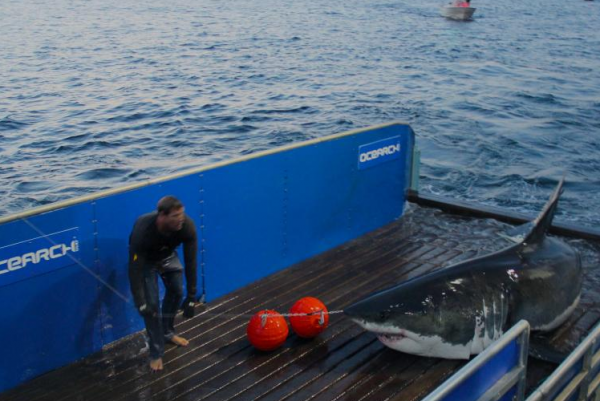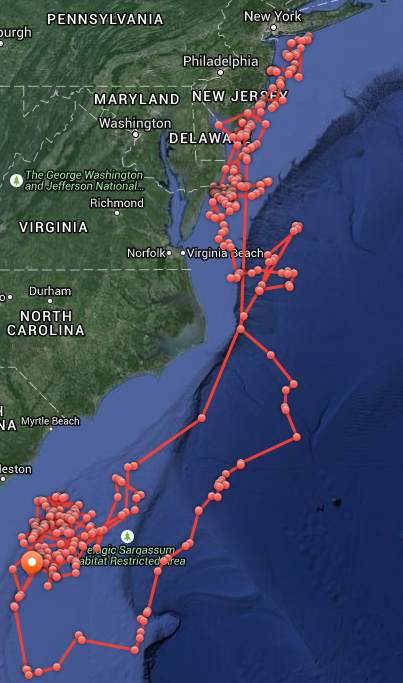2017 Update: In early May, Mary Lee passed by the mouth of the Chesapeake Bay and is currently heading north past Ocean City, "maybe going to look for a mate," according to OCEARCH.
Who remembers Mary Lee? She is a 16-foot long, 3456-pound female Great White shark. She also happens to be one of the most popular sharks since Jaws. Mary Lee first visited our shores in early May, and seemed to enjoy Assateague Island as much as the rest of us (at one point even traveling inside Chincoteague Bay), much to the chagrin of beach-goers. Marylanders were even more stunned when Mary Lee's tracker pinged
inside the Chesapeake Bay on her tracker site, OCEARCH. This was later determined to be a false ping. Her most recent surfacing was on August 1st off the coast of Georgia.

OCEARCH is a non-profit organization dedicated to the study of Great White Sharks and other large Apex predators. Scientists from the organization have been studying Mary Lee's movements since 2012 when she was tagged off the coast of Cape Cod. Sharks are tagged completely awake and unharmed. The video below shows the tagging of OCEARCH shark Lydia in 2013 off the coast of Jacksonville, FL.
https://youtu.be/-IJ0uLh9UAs
Research expeditions are conducted worldwide aboard the M/V OCEARCH, which serves as both a mothership and at-sea laboratory. Utilizing a custom 75,000 lb. capacity hydraulic platform designed to safely lift mature sharks for access by a multi-disciplined research team, up to 12 studies (blood tests, tissue samples, ultrasounds) are conducted in approximately 15 minutes on a live mature shark. The tags last about four or five years — as long as their batteries hold up.

Since her tagging, Mary Lee has traveled more than 19,000 miles. She mostly sticks to the waters off the East Coast but once swam as far east as Bermuda. Before surfacing this May off the coast of Assateague National Seashore, Mary Lee had spent most of the year in the cold, deep waters off the coast of South Carolina and Georgia. Whenever she breaks the surface, her tag will 'ping' on OCEARCH's website and both the scientists and the public can track her movements.
Mary Lee even has her own
Twitter account with over 88,000 followers! The hope is that "celebrity sharks" like Mary Lee and her fellow OCEARCH comrades will help to change perceptions among the public.
Peter Bordes, an OCEARCH board member said that these “celebrity sharks” are helping to form passionate, caring communities around the often-demonized fish. “People talk about [the sharks], humanize them,” Bordes told the Christian Science Monitor. “It changes perceptions.”
You can track her movements, and the movements of other tagged sharks, on
OCEARCH's Shark Tracker.
 OCEARCH is a non-profit organization dedicated to the study of Great White Sharks and other large Apex predators. Scientists from the organization have been studying Mary Lee's movements since 2012 when she was tagged off the coast of Cape Cod. Sharks are tagged completely awake and unharmed. The video below shows the tagging of OCEARCH shark Lydia in 2013 off the coast of Jacksonville, FL.
https://youtu.be/-IJ0uLh9UAs
Research expeditions are conducted worldwide aboard the M/V OCEARCH, which serves as both a mothership and at-sea laboratory. Utilizing a custom 75,000 lb. capacity hydraulic platform designed to safely lift mature sharks for access by a multi-disciplined research team, up to 12 studies (blood tests, tissue samples, ultrasounds) are conducted in approximately 15 minutes on a live mature shark. The tags last about four or five years — as long as their batteries hold up.
OCEARCH is a non-profit organization dedicated to the study of Great White Sharks and other large Apex predators. Scientists from the organization have been studying Mary Lee's movements since 2012 when she was tagged off the coast of Cape Cod. Sharks are tagged completely awake and unharmed. The video below shows the tagging of OCEARCH shark Lydia in 2013 off the coast of Jacksonville, FL.
https://youtu.be/-IJ0uLh9UAs
Research expeditions are conducted worldwide aboard the M/V OCEARCH, which serves as both a mothership and at-sea laboratory. Utilizing a custom 75,000 lb. capacity hydraulic platform designed to safely lift mature sharks for access by a multi-disciplined research team, up to 12 studies (blood tests, tissue samples, ultrasounds) are conducted in approximately 15 minutes on a live mature shark. The tags last about four or five years — as long as their batteries hold up.
 Since her tagging, Mary Lee has traveled more than 19,000 miles. She mostly sticks to the waters off the East Coast but once swam as far east as Bermuda. Before surfacing this May off the coast of Assateague National Seashore, Mary Lee had spent most of the year in the cold, deep waters off the coast of South Carolina and Georgia. Whenever she breaks the surface, her tag will 'ping' on OCEARCH's website and both the scientists and the public can track her movements.
Mary Lee even has her own Twitter account with over 88,000 followers! The hope is that "celebrity sharks" like Mary Lee and her fellow OCEARCH comrades will help to change perceptions among the public.
Peter Bordes, an OCEARCH board member said that these “celebrity sharks” are helping to form passionate, caring communities around the often-demonized fish. “People talk about [the sharks], humanize them,” Bordes told the Christian Science Monitor. “It changes perceptions.”
You can track her movements, and the movements of other tagged sharks, on OCEARCH's Shark Tracker.
Since her tagging, Mary Lee has traveled more than 19,000 miles. She mostly sticks to the waters off the East Coast but once swam as far east as Bermuda. Before surfacing this May off the coast of Assateague National Seashore, Mary Lee had spent most of the year in the cold, deep waters off the coast of South Carolina and Georgia. Whenever she breaks the surface, her tag will 'ping' on OCEARCH's website and both the scientists and the public can track her movements.
Mary Lee even has her own Twitter account with over 88,000 followers! The hope is that "celebrity sharks" like Mary Lee and her fellow OCEARCH comrades will help to change perceptions among the public.
Peter Bordes, an OCEARCH board member said that these “celebrity sharks” are helping to form passionate, caring communities around the often-demonized fish. “People talk about [the sharks], humanize them,” Bordes told the Christian Science Monitor. “It changes perceptions.”
You can track her movements, and the movements of other tagged sharks, on OCEARCH's Shark Tracker.